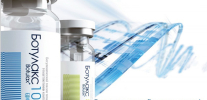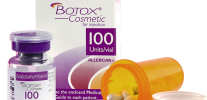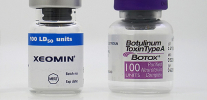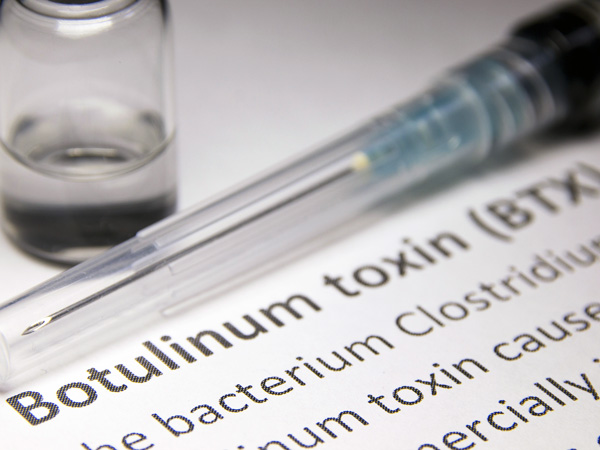
Perhaps the main thing that confuses many patients before deciding to undergo botulinum toxin therapy is the presence of the word “toxin” in the name of the drug itself. Learning that botulinum toxin is used for a seemingly safe and widespread procedure, many women begin to wonder if this remedy is associated with any toxic substance. And finding out the truth, they are often surprised.
Indeed, botulinum toxin, or botulinum toxin, is one of the most powerful poisons in nature, which is widely used today as a cosmetic product, and only a few substances known to science can compare with in terms of poisoning power.
So, fatal poisoning of an adult requires only 0.08-0.1 μg (less than one millionth of a gram) of botulinum toxin, or 0.001 μg per 1 kg of body weight. For comparison, the lethal dose of potassium cyanide (the strongest inorganic poison) for humans is 1.7 mg per kg of body weight - 1.7 million times more. That is, botulinum toxin is approximately 1.7 million times more toxic than potassium cyanide.
Despite its toxicity, botulinum toxin is quite common in nature, and you can encounter it even in everyday life. Other highly toxic natural substances, as a rule, are found in nature much less frequently.
For example, the known poison batrachotoxin can be found in organisms of exotic endangered South American frogs, and curare is obtained from plants of the genus Strychnos, also growing in South American selva. That is, by chance, it is difficult to encounter these poisons in everyday life.
Botulinum toxin, by virtue of its origin, can appear literally anywhere - in the earth, in food, and in some cases directly in the human body. Its use leads to severe poisoning, and even death.
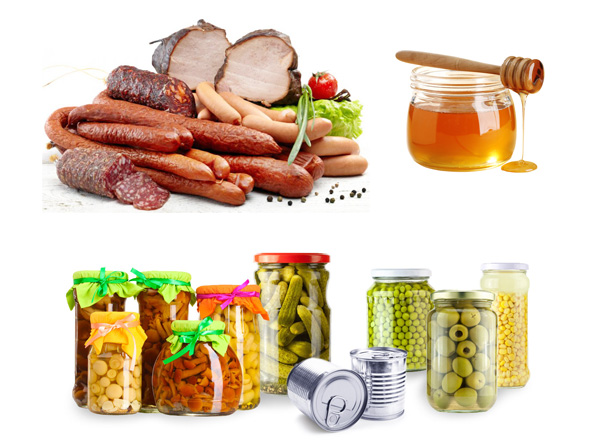
Botulinum toxin can be present in spoiled canned food, sausages and even in honey.
It is this substance, highly toxic and generally very dangerous, that is really used in injection cosmetology. That is, doctors intentionally inject it into the patient's body to obtain a cosmetic effect. Moreover, these procedures are safe and give such a pronounced result that the popularity of Botox is growing by leaps and bounds, and its producers earn billions.
On a note
Only one of the producers of botulinum toxin, even the most famous for today - the Allergan company, in 2015 declared revenue of $ 15 billion, and net income of $ 1 billion. Turnover and profit of the company increase by about 8-12% every year.
What is botulinum toxin? When should it be treated as a powerful poison, and when should it be considered as a medicine?
A bit of history
It is believed that botulinum toxin poisoning has occurred in humans throughout the history of human civilization. At least, knowing the biology of the "producer" of this substance, there is no doubt that people could encounter it in all historical eras.
The oldest report on botulinum toxin is considered to be the decree of the Byzantine emperor Leo IV on the prohibition of eating black pudding, published in about 900 AD. e. This decree was an attempt to reduce the number of deaths from sausage poisoning. Historians believe that it was the botulinum toxin that appeared in the Byzantine “blood-tree” due to the specifics of its preparation, and was the cause of poisoning and death.
The first documented evidence of botulinum toxin poisoning was the case of poisoning 13 people in Germany in 1793. At that time, neither the people themselves nor the doctors knew about the causes of intoxication, but they clearly associated the disease with the use of sausages.Actually, then the disease got its name - “botulism”, from the Latin word “botulus” - sausage.

The Latin word "botulus", which means "sausage", was the basis for the name of the disease that occurs when poisoning with black pudding (botulism).
In describing the Napoleonic wars, historians have already reported botulism many times, and in some cases there have been massive poisonings, mainly in rural areas. However, the hypothesis that the disease was caused by a low level of hygiene was generally accepted then.
Around the same time, the disease was described in Russia under the name ichthyism. Here she was associated with the use of salted and smoked fish.
Already in 1817, the German medical writer Justinus Kerner described the disease in detail. Interestingly, even then, introducing a toxin to himself to study symptoms, he suggested that in small amounts the poison that causes botulism can be used to treat involuntary muscle contractions and nerve tics.
Finally, the causative agent of botulism and its natural producer were discovered in 1895 by the Belgian bacteriologist Emil vas Ermengem. He was investigating the poisoning of 34 musicians at the funeral, when 3 people died and 10 were in the hospital with severe poisoning for a long time after having treated themselves to home-made ham. The scientist isolated Bacillus botulinus from the ham (literally - “sausage bacillus”), and also found that the toxin itself is produced by bacteria directly in food, and with them it enters the human digestive tract, leading to poisoning.
Then the factor causing poisoning and associated with the detected bacteria got its name - botulinum toxin.
Later, after discussions, the taxonomists classified the causative agent of botulism to the genus Clostridium and gave it the full name Clostridium botulinum. And chemists and microbiologists gradually, as the studies were conducted, described the basic properties of the neurotoxin produced by these bacilli.
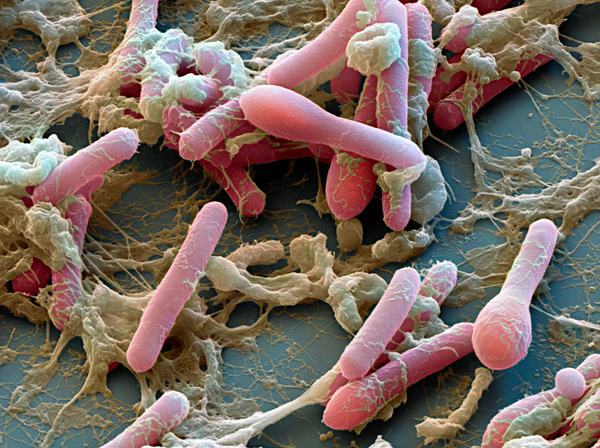
Bacteria of Clostridium botulinum are sticks of 3-9 microns in length.
On a note
The wrong name for the poison is botulinum. Such a term is not used either in microbiology or in medicine.
Further careful study of the pathogen made it possible to understand the cause of food contamination and to develop ways to prevent the production of toxin. All this led to the fact that the number of cases of botulism was significantly reduced, although individual poisoning and even local outbreaks occur in different parts of the world.
Almost a century after the discovery of the pathogen and the toxin itself, in 1973, the scientist Alan Scott showed that point injections of botulinum toxin into hyperkinetic muscles can temporarily reduce or completely eliminate the strength of involuntary contractions. From this moment began the history of botulinum toxin, as a medical and cosmetic preparation.
Properties of botulinum toxin and its toxic effect
Already during the first studies, scientists found that the botulinum toxin molecule is abnormally large. Its dimensions are approximately three times the average size of protein molecules, and of the proteins known in organic chemistry, only a few molecules exceed the size or weight of the botulinum toxin molecule.
So, the chemical formula of the botulinum toxin molecule is C6760H10447N1743O2010S32, that is, in one molecule it contains 6760 carbon atoms, 10447 hydrogen atoms, 1743 nitrogen atoms, 2010 oxygen atoms and 32 sulfur atoms.
The botulinum toxin molecule consists of two chains - heavy and light, each of which performs its function. The heavy chain is responsible for the binding of the molecule to receptors on the surface of the nerve cell for further penetration of the protein inside, and the light chain inactivates the SNAP protein inside the neuron itself - this reaction triggers a cascade of processes that may ultimately result in the death of the body.

Botulinum toxin molecule
There are no poisons known to science that have larger molecules than botulinum toxin molecules. The tetanospasmin, which is similar in its properties, produced by the tetanus pathogen, has a similar structure and principle of toxic effects, but its molecule is smaller. Therefore, the toxicity of tetanospazmin is lower than that of botulinum toxin (which, of course, does not, tetanus is less dangerous than botulism, a disease).
For comparison, the molecular mass of a botulinum toxin molecule is 150 thousand atomic mass units (a.u. m.), And the mass of a tetanospasmin molecule is 140 thousand a. eat.
It is interesting
It is believed that in accordance with Darwin’s theory of natural selection, living organisms are in principle incapable of synthesizing toxins that are more toxic than botulinum toxins. However, this point of view is disputed by some authors.
By the strength of the toxic effect, botulinum toxin is 250 million times higher than hydrocyanic acid and 70 thousand times the most toxic synthetic substance, dioxin.
At the same time, the antidote to botulinum toxin is not known today. In medicine, a single or multivalent antitoxic anti-botulinum serum is used as an antidote, obtained from the blood of horses that were injected with an toxoid according to a special scheme. Such serum is not commercially available, is available only to doctors in medical institutions and requires high professional skills for administration.
Since the toxin is a protein, it can be present both in liquid solutions and in dry raw materials. By itself, it has no smell and color, and therefore it is impossible to identify its presence in products. However, the bacterium itself can “give out” the toxin - if there are a lot of bacilli in the sausage, the product has a smell of rancid vegetable oil, caused by gases released by the bacteria in parallel.

Bacteria Clostridium botulinum under the microscope.
Botulinum toxin is quite resistant to high temperatures. When boiling, it denatures and loses its poisonous properties after half an hour, in an autoclave at 120 ° C it is destroyed in 10 minutes.
Interestingly, this toxin is destroyed in a 1% solution of baking soda in ten minutes, but it easily transfers alkalization and acidification of the medium normally. In an alkaline environment, its destruction occurs faster than in an acidic one.
Identification of these properties allowed in due time to formulate the principles of disinfection of products that may contain botulinum toxin. So, today, to protect against poisoning, sausages, meat, fish or vegetables that were stored or were in the absence of oxygen at the cooking stage, it is recommended to carefully boil or fry.
However, even more effective prevention of poisoning is considered the rejection of the use of potentially contaminated food products. For example, obviously “bombing” canned food is clearly safer to throw away than to try to somehow process to destroy the toxin. It’s dangerous to try to somehow determine the presence of clostridia by bloating the lid, so that you can then use canned food.
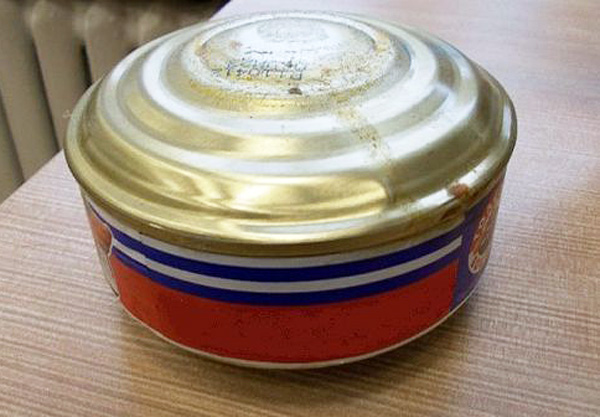
Do not eat "swollen" canned food, as there is a high probability of the presence of pathogens in them.
It is noteworthy that despite the unique properties of botulinum toxin, several of its types are known. According to the most common classification, there are 9 of these types - A, B, C1, C2, D, E, F, G, H. All of them differ in structural features of the molecule and properties, including toxicity.
For example, in decreasing toxicity, these types are arranged as follows:
- Type D - lethal dose for mice (the so-called LD50) 0.0004 mcg / kg;
- Types C and E - lethal dose for mice 0.0011 mcg / kg;
- Types A, B, C2 - lethal dose for mice 0.0012 mcg / kg;
- Type F is the lethal dose for mice of 0.0025.
The most common in nature, the most studied and demanded in medicine and cosmetology is type A botulinum toxin. In addition to it, type B botulinum toxin is used in some drugs and, for experimental purposes only, type C, D toxins and some others are used. All these types were initially divided according to the serovars of their producer bacteria, and only later it was shown that their molecules have different structures, and the proteins themselves are slightly different in their properties.
On a note
Almost all studied cases of botulism in humans were caused by botulinum toxins of type A, B or E.
Bacteria Clostridium botulinum as the main "producers" of toxin
Today, microbiologists have no consensus on whether to consider Clostridium botulinum as one species, or a group of bacterial species. Different lines of these bacteria have genetic differences, the severity of which does not allow us to clearly divide them into species, but the toxins produced by them have approximately the same effect on the human body.
However, the biology of these species is almost the same.
It has also been shown that a similar botulinum toxin type F is produced by the bacterium Clostridium baratii, and type E by Clostridium butyricum.
All these bacteria belong to anaerobic organisms that can exist and multiply only in the absence of oxygen. Normally, they live in the soil in those cavities in which air with oxygen does not penetrate, most often in the soil and silt at the bottom of water bodies, often in fish and other aquatic animals.
If oxygen is present in the environment, the vegetative forms of C. botulinum die, but spores remain, which can then germinate when exposed to anaerobic conditions. For this reason, bacteria develop only in dense foods (meat and fish, cut into large pieces, sausage), or canned food in hermetically sealed jars, where they and the toxin produced by them are located in the thickness of the product.
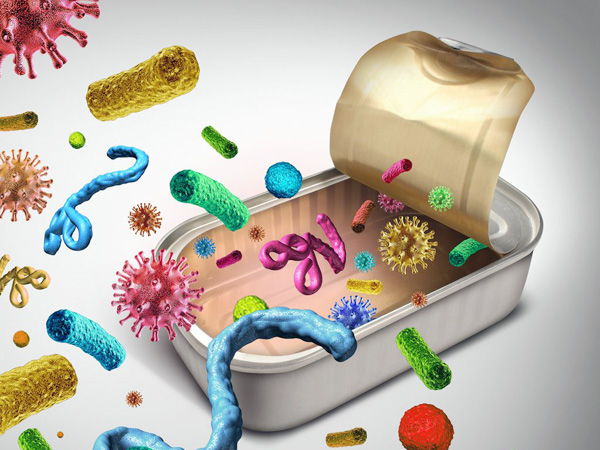
Spores of C. Botulinum can germinate in the absence of oxygen, in particular in canned or sealed products.
The optimum temperature for the development and reproduction of these bacteria is 26-36 ° C. The closer the temperature is to the upper limit of the optimum, the better the spores are retained in the presence of oxygen, and the faster the bacteria multiply under anaerobic conditions.
The classic food contamination scenario with clostridia looks like this:
- Spores of bacteria with dust, earth or air get with food in containers for canning, or with meat in a package for sausage;
- After closing the container or tying the "gut" for sausage, optimal anaerobic conditions are formed in which spores begin to germinate with the appearance of vegetative forms of bacteria;
- Clostridia multiplies with the release of their metabolic products, including botulinum toxin.
If you subsequently use such a product as food, botulinum toxin will enter the digestive tract and lead to poisoning.
Actually, in the human body, clostridia themselves do not multiply, do not develop, and the toxin does not produce. They can not exist and multiply in the digestive tract for various reasons:
- The presence of oxygen here, albeit in small quantities;
- High competition from saprophytic microflora ("local" bacteria inhibit the growth of clostridia);
- High acidity;
- The death of most bacteria during cooking or in contact with air.
Therefore, simply eating, for example, vegetables and fruits directly “from the garden” on which the earth is kept, the clostridia themselves and their spores, is not dangerous. There are two exceptions to this rule:
- Land with bacteria or their spores getting into scratches or open wounds (even small ones). Subsequently, the wound is healed by a crust from the blood or lymph, free oxygen disappears in it and the development of bacteria begins with the release of botulinum toxin;
- The ingestion of clostridia or their spores in the digestive tract of a newborn baby. In young children who have not started to eat solid foods, the acidity of the gastrointestinal tract is reduced, and the intestinal microflora is not yet sufficiently active. Under these conditions, clostridia can multiply and cause botulism. It is believed that in such small children, the main source of bacteria infection is honey, in which spores can get from the legs of bees collecting pollen. For this reason, it is not recommended to give honey to children in the first months of life. After the beginning of feeding a child with solid food, the acidity of the stomach and intestines increases, the number of symbiont bacteria increases, as a result of which conditions are created in which clostridia can no longer multiply.

In some cases, honey can become a source of botulinum toxin poisoning.
Interestingly, the first variant of infection is similar to that for tetanus. Only in tetanus, pathogens usually enter the body cavity when the animal bites, when infected saliva penetrates deep into the soft tissues, the wound quickly heals, but the tetanus pathogen, C. tetani clostridium, begins to multiply in the tissue and secrete tetanus toxin.
Clostridia spores themselves are more resistant to external influences than the toxin itself. For example, they can withstand boiling for 6 hours and exposure to 10% hydrochloric acid for 40 minutes.
C. botulinum are ubiquitous except in areas with constantly low temperatures (for example, they are absent on mountain peaks and in glaciers). Therefore, infection and poisoning of their products can occur in almost any part of the world.
However, the incidence of botulism throughout the world is low. According to statistics, about 1000 cases of botulism are registered every year around the world, mortality is approximately 12-13%.
The botulinum toxin produced by bacteria is a complex of toxin and several non-toxic auxiliary proteins. The latter protect the toxin from the action of various enzymes and acids, due to which the entire aggregate from almost anywhere in the body can penetrate the blood and reach the target cell, attach to it and transported inside. After this, the poisonous effect begins.
The principle of action of botulinum toxin on the nervous system and muscles
Botulinum toxin acts selectively on nerve cells at synapse sites - the attachment of neurons to muscle cells. In these synapses, when a nerve impulse enters the neuron, the neurotransmitter acetylcholine is released, which leads to irritation and contraction of muscle fiber. This implements the process of muscle control with the help of nerve centers - the spinal cord or brain.
The process of poisoning at the cellular level looks like this:
- When botulinum toxin with blood reaches a particular muscle, it moves along the muscle fiber until it randomly encounters specific receptors on the surface of a nerve cell;
- After binding to the receptor with a heavy chain, the toxin molecule is absorbed by the cell itself and penetrates the synapse. Here auxiliary proteins are separated from it, and the light chain combines with the SNAP protein, whose task is to stimulate the release of acetylcholine from special vesicles inside the synapse;
- SNAP is inactivated, and upon receipt of a nerve impulse, acetylcholine and muscle contraction are not excreted.
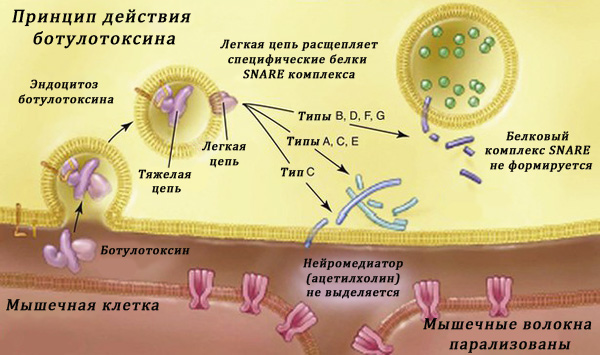
The principle of action of botulinum toxin on nerve endings and muscles.
In fact, chemo-denervation develops when no signals from the brain stimulate muscle contraction.
In parallel with the effects of botulinum toxin, other pathological phenomena occur:
- The binding of oxygen by red blood cells is broken;
- The activity of the parasympathetic nervous system decreases, the absorption of oxygen by tissues is weakened;
- Hemodynamic disturbances develop.
In the whole body, this leads to deadly effects:
- Diaphragm contractions weaken and hypoxia develops;
- Paresis of the larynx, pharynx and epiglottis develops, due to which saliva starts to flow down into the bronchi and even vomit can penetrate (a person cannot cough up them due to denervation of muscles);
- Heart rhythm is disturbed;
- Acute respiratory failure develops. It is she who is the main cause of death in botulism.
In some cases, attached secondary bacterial infections may be life threatening.
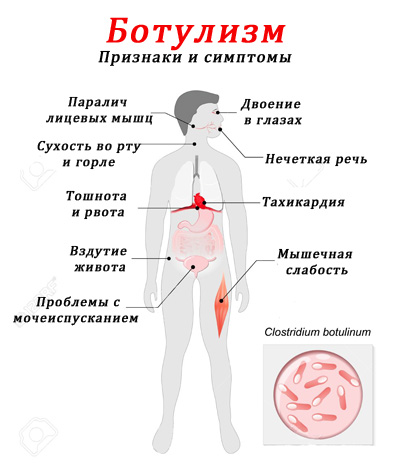
Symptoms of Botulism
In case of poisoning, botulinum toxin can affect the nervous tissue in any part of the body. It is noteworthy that denervation of sensory nerves does not occur, and the victim maintains a complete picture of sensations - he hears, sees (although vision is usually impaired due to denervation of the eye muscles), he feels pain and touch the skin. This combination of extensive deep paralysis while maintaining complete sensitivity is a characteristic diagnostic sign of botulism.
How and what can be poisoned?
Food poisoning in most cases occurs when eating foods containing botulinum toxin already produced by bacteria. Typically, these are:
- Various canned foods (most often home-made), not only meat, but also vegetable, mushroom (canned fried mushrooms are especially dangerous), when prepared, spores of clostridia get into the product, and in which, after twisting, optimal conditions for the development of bacteria are formed. Propagating, clostridia emit a large number of different gases, which is why the pressure in the container rises and characteristic bloats appear on the lids of the cans. Such canned food is called "bombing" and it is very likely that their use in food will lead to poisoning. After their discovery, the bacteria themselves die due to oxygen entering the product, but the botulinum toxin persists;
- Sausages and meat products made from minced meat chopped or minced in a meat grinder, then laid in a shell. Here, in the shell, there is also no oxygen, which creates conditions comfortable for bacteria;
- Fish - dried, salted, pickled, cooked without access to oxygen.
All these products usually do not show the presence of bacteria, either by smell, or by taste, or by any other signs. Only with severe infection can an unpleasant smell of rancid oil appear in them.
Also, botulinum toxin poisoning can occur in the following ways:
- Land, dust, dirt getting on an open wound, accidental injection of a contaminated object (for example, a nail);

Spores of a botulinum bacillus can get into a wound, for example, together with the earth.
- Ingestion of clostridial spores as a child in the first months of life. This can happen both with the deliberate treating of the baby, for example, with honey, and the accidental ingestion of various contaminated objects in his mouth - toys that have fallen on the floor before things.
Despite the seemingly simplicity of poisoning by contaminated canned food and, conversely, the low likelihood of poisoning a newborn child, global statistics show that of all cases, newborn botulism accounts for 65% of poisonings, 20% for wound botulism, and only 15 for the food form of the disease %
It is interesting
It is known that the father of the famous poet Vladimir Mayakovsky died of tetanus, pricking his finger with a needle. In this way, infection with spores of C. botulinum can occur, especially since tetanus and botulinum bacilli have a similar biology.

Clostridium tetani (tetanus bacillus) and the bacterium C. Botulinum are largely similar to each other both in structure and in biology.
It is also possible poisoning when the toxin enters the lungs with inhaled air or when it enters the mucous membranes of the eyes. This was proved during experiments on monkeys, and then used for military purposes to create chemical weapons. Such combat botulinum toxin under the code XR was supposed to be sprayed over places of concentration of enemy manpower to poison people. However, today there are no known cases of actual use of botulinum toxin for military purposes.
It is interesting
It is believed that it was the botulinum toxin that poisoned the filling of the grenade, wounds from the fragments of which led to the death of Reinhard Heydrich, Hitler's protege in occupied Czechoslovakia. However, some historians question this version.
From the foregoing, methods to reduce the risk of toxin poisoning become apparent:
- Observe hygiene when caring for the baby. This does not mean maintaining complete sterility (this is also an undesirable extreme), but also to allow unwashed things into the child’s mouth, and even more so, simply the earth is unacceptable;
- Treat random wounds and scratches with antiseptics, in extreme cases, simply rinse them as quickly as possible after injury, until the wound has healed;
- Do not eat obviously suspicious foods - canned food from swollen cans, sausages, smoked meat and fish with an unpleasant odor;
- Before use, subject all meat products and fish to heat treatment - frying, continuous cooking. This will destroy both botulinum toxin and the bacteria that produce it, and with a certain probability of their spores.

To minimize the risk of poisoning by meat and fish products, they must be subjected to prolonged heat treatment.
Nevertheless, even observing these rules, you need to know how botulism manifests itself, and be prepared to take the first necessary measures if someone close has the corresponding symptoms.
Signs of botulinum toxin poisoning
The first signs of botulism are generally similar to the symptoms of ordinary food poisoning. The victim develops diarrhea, nausea, vomiting, abdominal pain. It is noteworthy that diarrhea itself lasts relatively short (less than a day), because due to the action of the toxin paresis of the intestinal muscles develops and excrement ceases.
These symptoms develop on average within a day after the use of poisoned foods, but sometimes the incubation period can be as few as a few hours, and in other cases it stretches to 3-4 days.
At the end of diarrhea, the patient feels bloating, flatulence. In this case, he develops constipation. All this set of symptoms indicates the cessation of active intestinal muscle peristalsis and the processes of food fermentation in the gastrointestinal tract.

The occurrence of constipation during poisoning may indicate a violation of intestinal motility caused by a toxin.
In parallel, the symptoms of neurological disorders develop:
- Weakened vision due to paresis of accommodation, the inability to read and focus the gaze, visual effects in front of the eyes - “grid”, “fog”, “flies”;
- Eyelid prolapse (ptosis);
- Hanging head due to weakness of the occipital muscles;
- Violations of diction, difficulty in protruding the tongue;
- Superficial very weak breathing;
- Hyposalivation, drying out of the oral mucosa;
- General weakness, malaise.
In most cases, these signs develop against the background of normal body temperature and with full preservation of sensitivity.
However, treatment for botulism should begin before paresis occurs. Therefore, you should consult a doctor at the first sign of poisoning, especially if it is known that the patient ate canned food or meat products.
First Aid Rules and Intoxication Treatment
At the first signs of poisoning, it is recommended to call an ambulance and carry out the following manipulations:
- To induce vomiting of the victim (exposure to the root of the tongue with a finger, consumption of 0.5 liters of salt water);
- Allow several tablets of activated carbon or microcrystalline cellulose to be swallowed and washed with water.

At home, as a first aid for poisoning, it is necessary to induce vomiting.
Other effective measures at home are not available. The probability of a successful outcome will depend on the speed of delivery of the victim to the hospital.
Already in a hospital, they carry out such treatment:
- Gastric lavage with a special probe to remove the remains of poisoned food;
- Intestinal dialysis or multiple cleansing enemas to diffuse the toxin from the intestinal epithelium into the solution. Usually, a 5% solution of soda is used for this purpose, but in a serious condition of the patient, solutions with the addition of glucose and other substances can be used to prevent their diffusion from the body;
- The introduction of anti-botulinum serum or native homologous plasma. Such an introduction is very difficult, its technique requires a preliminary determination of the presence of an allergy to serum components. If there is an allergy, the drug is administered under the guise of antihistamines or glucocorticoid drugs, and the administration algorithm must be observed taking into account the rate of development of intoxication, and after input it is necessary to monitor the patient's condition in order to identify possible allergic reactions in time. In addition, the instructions for use require the correct alternation of sera against toxins of various types. Obviously, only a doctor should carry out these manipulations.
With timely treatment, these procedures are usually enough to normalize the patient's condition and gradual detoxification. In more severe cases, you may need:
- Artificial ventilation of the lungs with an increased amount of oxygen;
- Antibacterial therapy (primarily to combat associated infections);
- The introduction of diuretics, metabolites, vitamins, glucose;
- The use of glucocorticoids to cover drugs that can cause sensitization.
Recovery after illness occurs very slowly due to the duration of regeneration and the appearance of new nerve synapses instead of inactivated ones. The longest (up to several months) vision is restored.
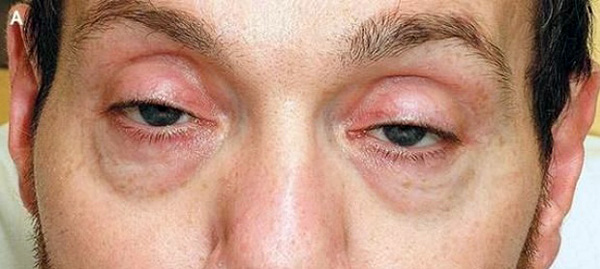
After severe poisoning with botulinum toxin, vision is restored the longest.
It is noteworthy that, despite the severity of the symptoms of the disease, after recovery, usually there are no consequences. Almost never botulism leaves immunity, and analysis for antibodies after it does not reveal immunoglobulins to botulinum toxin. This is due to the fact that poisoning occurs with very small doses of poison, to which the body simply does not respond. For this reason, incidentally, the introduction of botulism in the history into the list of contraindications for Botox injections or similar drugs seems somewhat redundant. The vast majority of people who have had botulism are still susceptible to botulinum toxin.
The use of botulinum toxin in medicine and cosmetology
Despite the acute toxic effect, botulinum toxin is used as a medicine and cosmetic product, and its popularity is constantly growing.
The main purpose of its use in medicine is denervation and immobilization of excessively active muscles. In clinical cases, this may be necessary, for example, in the following conditions:
- Various spasms;
- Strabismus caused by tension of the eye muscles;
- Tremor of hands;
- Cerebral palsy;
- Cervical dystonia;
- Wrist spasms after a stroke;
- Urinary incontinence in urology associated with hyperactivity of the muscle compressing the bladder.

In medicine, one of the areas of application of botulinum toxin is the treatment of spastic forms of cerebral palsy.
Also, the use of botulinum toxin can reduce the symptoms of chronic migraine and hyperhidrosis (sweating).
However, botulinum toxin was most widely used in cosmetology. Here it is most often used to immobilize the facial muscles of the face, which allows you to get rid of the deepest dynamic wrinkles. In this case, the toxin is administered in small doses strictly locally to the target muscles. Here it quickly penetrates into neuromuscular synapses, has a local effect, and does not produce a toxic effect on the body as a whole.
For the same purpose, it is used as a neurotoxin for the correction of some other cosmetic defects - excessively protruding muscles, too rough forms in former athletes (for example, to smooth the appearance of massive muscles of the shoulder girdle).
It's important to know
Both in pharmacology and cosmetology, botulinum toxin is considered exclusively as a topical agent. When introduced into the muscles, it does not lead to poisoning, but has a therapeutic or cosmetic effect. If it enters the digestive tract, lungs or the mucous membrane of the eyes, it will lead to poisoning.
Often, botulinum therapy is considered as part of a whole range of cosmetic procedures. Toxin injections alternate with the introduction of fillers, DMAE, the use of "golden threads". It is worth noting that at the same time as botulinum toxin, it is not recommended to use other cosmetics to avoid a decrease in the effectiveness of botulinum therapy.
For cosmetic and medical purposes, botulinum toxin is obtained from cultures of clostridia grown in containers with a special nutrient broth. At a certain stage, neurotoxin itself is isolated from this broth, it is thoroughly cleaned (its cleaning cost may exceed the cost of cultivating the bacteria and preparing the drug itself), and the final drug is prepared either in powder form or in the form of a toxin solution. And, by the way, due to the difficulties of obtaining, cleaning and transportation, the price of the final product is quite high.
In view of the enormous popularity of botulinum toxin injections, its production today is carried out in large laboratories on a truly industrial scale. It enters the market under various trade names, the most famous of which are Botox (it has already become a household name), Dysport and Xeomin. Among them, Xeomin stands out by the fact that it is a pure botulinum toxin preparation, while the rest of the preparations contain a complex of botulinum toxin type A with hemagglutinin proteins.
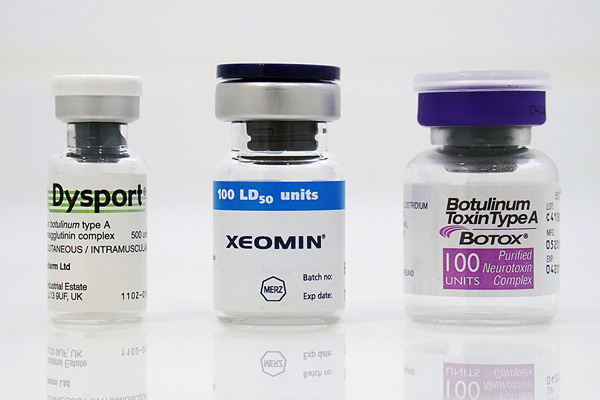
Among the most popular botulinum toxin preparations: Botox, Dysport, Xeomin.
On a note
It is not entirely correct to say that Botox and botulinum toxin are one and the same. The difference between these concepts is great, they indicate different categories. Botulinum toxin is an active substance of the Botox drug, which also contains auxiliary components. But in general, for the patient, these concepts are equivalent - the introduction of Botox into the body means the introduction of the neurotoxin itself.
The only type B botulinum toxin drug available today is Mioblock. It is used in cases where patients develop resistance to type A neurotoxin, and the corresponding drugs do not give the desired effect.
Every year, more and more new drugs are introduced to the market - Hutox (Hutox), Refinex (synonym - BTX 100), Meditoxin, Zentex and others. Their characteristics are generally similar, and the main criteria for choosing between them and more well-known drugs are price, effectiveness and safety.
It should be noted that it is precisely due to the development of competition, the entry of new manufacturers into this market and the appearance of new products that the price of botulinum toxin itself and the services for its introduction are constantly decreasing. For example, today in Russia botulinum therapy is available not only to residents of Moscow and St. Petersburg, but also to patients in most major cities.
On a note
All the above preparations contain the same botulinum toxin, which in sausage or canned food is a strong poison. Local use of these drugs as injections into the muscles will not lead to poisoning, but if the contents of such a bottle enter the digestive tract, it can cause poisoning and typical botulism.
In addition, today it is proved that botulinum toxin can have a cosmetic effect, albeit a weaker one, even with a simple application to the skin.In this regard, it became possible to buy drugs that do not require injections - various serums (for example, Bodyton), special lotions. Moreover, unlike botulinum toxin, these funds can be bought in an online store or pharmacy and used independently. Nevertheless, their effectiveness in the correction of wrinkles is not yet as reliably tested as the effectiveness of injectable preparations.
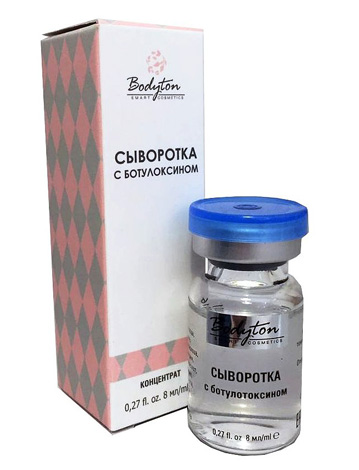
Bodyton Botulinum Toxin Serum for the treatment of facial wrinkles.
It is important to understand that the local administration of cosmetics with botulinum toxin is quite safe. Actually, botulism and poisoning do not occur with such procedures. This is confirmed by special studies, and reviews, and the experience of doctors. Undesirable consequences from the cosmetic use of botulinum toxin are manifested only because of allergic reactions to it and some other phenomena that can be dangerous (deaths from the use of botulinum toxin preparations are known), but have nothing to do with, in fact, poisoning with botulinum toxin.
So botulinum toxin is one of the brightest evidence of the rule: everything is poison and everything is a medicine; both determine the dose. Only in the case of botulinum toxin will it be poison, or a medicine, determined by the way in which it enters the body.
An interesting video about the effect of botulinum toxin on the body in case of poisoning
The use of botulinum toxin in cosmetology


